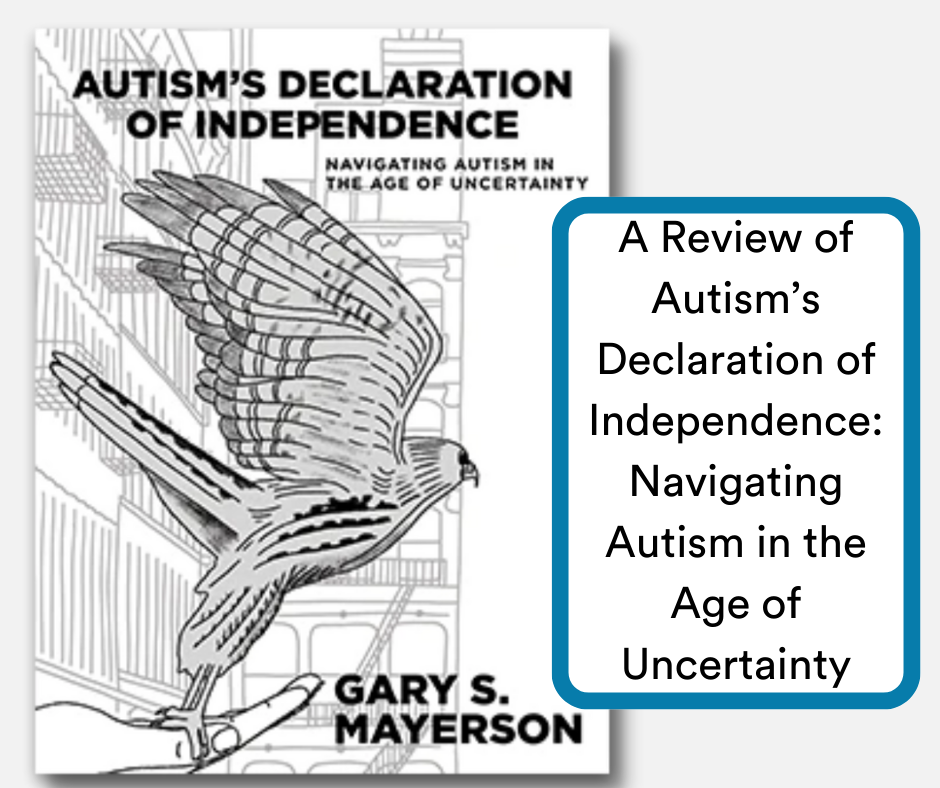
This month’s ASAT feature comes to us from Marcia Questel, BCBA, Content Editor, and Executive Director David Celiberti, PhD, BCBA-D, Association for Science in Autism Treatment. To learn more about ASAT, please visit their website at www.asatonline.org. You can also sign up for ASAT’s free newsletter, Science in Autism Treatment, and like them on Facebook!
The autism community has many fine advocates for individuals with autism and their families and Gary Mayerson is one of the finest. Prior to sharing a review of the contents of the book, we wanted to provide a bit of background for our readers. Just weeks before Autism’s Declaration of Independence: Navigating Autism in the Age of Uncertainty was published; the world was devastated by the COVID-19 pandemic. Rather than delay the distribution of the book, Mr. Mayerson expanded its contents to address systems turned upside down and new challenges facing our community. So, beyond the high quality of the original content, these efforts shine through pages of COVID-19 dedicated content, aimed at assisting families with pandemic-related questions and concerns. At the same time, Mr. Mayerson was working behind the scenes to ensure that basic legal safeguards were not compromised. Along with helping the families he served to navigate service provisions through the pandemic, he was able to publish this informative book containing crucial information about individual and family rights with rich application before and during the pandemic, and thereafter.
Part 1 – Knowing Your Child’s Rights and How to Apply Them
Mr. Mayerson released a field guide for parents in 2004 titled How to Compromise with Your School District Without Compromising Your Child. He introduces this new 2020 book with how an “age of uncertainty” has developed since then, and he explains the issues being faced by individuals with autism and their families today. Part 1 is comprised of chapters that address a vast array of topics, many of which have become more salient given the current pandemic. Prior to highlighting several of these chapters, we wanted to provide readers with a list of topics to help them assess if this resource addresses their needs as well as which chapter may bear relevance to their current circumstances:
- Chapter 1: The autism diagnosis and its impact on the family
- Chapter 2: What does the right to a “free and appropriate” education mean for my child?
- Chapter 3: Generalization
- Chapter 4: Managing your child’s right to be educated in the “least restrictive environment”
- Chapter 5: How can parents obtain independent evaluations at school district expense
- Chapter 6: How parents can manage and shape the IEP process
- Chapter 7: Considering claims against school districts – What relief is available?
- Chapter 8: When all else fails – Filing for an impartial hearing (due process)
- Chapter 9: Managing safety considerations
- Chapter 10: Dealing with suspensions and other disciplinary proceedings
- Chapter 11: The threat of criminal charges
- Chapter 12: When a residential placement may be warranted
- Chapter 13: Preparing for the transition to adulthood – The main event
- Chapter 14: Confronting bullying and discrimination in the workspace
- Chapter 15: Guardianship, special needs trusts, and powers of attorney
- Chapter 16: The advent of telehealth instruction during the COVID-19 pandemic
- Chapter 17: The road ahead – Institutionalizing high expectations and discontent
Although it is beyond the scope of this brief review to discuss each of the chapters, here is a sample of highlights. Note that there is so much more to find within this book, but these were selected to simply introduce readers to what they can expect.
Chapter 2: What does the right to a “free appropriate” public education mean for my child?
In this chapter, Mr. Mayerson (2020) explains the history of the development of a student’s right to a Free Appropriate Public Education (FAPE). Beyond how the laws developed, he defines what FAPE truly means and how schools must adhere to it. Importantly, this chapter provides and explains the educational laws by name, providing families with clarity and arming them with knowledge.
Chapter 4: Managing your child’s right to be educated in the “least restrictive environment”
This vital chapter highlights the need for students to be truly included in the educational opportunities offered in their school districts. Yet, there is an important balance that districts must strike between placing students in least restrictive environments and still providing all of the educational supports that they need for success. It begins with a mother’s personal story about inclusion and ends with important questions for parents to consider about inclusive placements. Between these, Mr. Mayerson (2020) describes laws pertaining to inclusion in depth, and his experiences advocating for least restrictive environments for students with autism.
Chapter 8: When all else fails – Filing for an impartial hearing (due process)
This chapter describes many issues related to filing for an impartial hearing for your child’s educational needs. Sections include “Litigating a Case Against the District’s ‘Teacher of the Year,’” “Do Parents Always Need to Hire Counsel to File for Due Process?”, “Preserving and Invoking your Child’s ‘Pendency’ Entitlements,” “Settlement Considerations,” and several others. This chapter thoroughly explains varying situations which may lead a caregiver to filing for an impartial hearing. It provides guidance for parents going through these challenging situations. Readers should take note of the many footnotes found within this chapter that provide even further clarity.
Chapter 9: Managing Safety Considerations
When parents of children with special needs share their priorities, they most often describe safety concerns. This vital chapter delves deep into issues related to elopement, fire and lockdown drills, COVID-19 related risks, unexplained injuries, police encounters, medications, allergies, bullying, and sexual abuse. Mr. Mayerson (2020) provides accounts of his experiences, and that of others, and shares practical advice that parents can take to help keep their children safe – as well as how to respond when they discover that their children have been in an unsafe situation.
Chapter 16: The advent of telehealth instruction during the COVID-19 pandemic
While this chapter was written towards the beginning of the pandemic, there is useful advice within it for parents today, especially considering that the pandemic is not over.While many school districts have opened their doors to in-person instruction, there are still others using hybrid and remote options. Furthermore, many districts are compelled to quickly return to online or hybrid instruction with spikes in community transmission, school-based outbreaks, or as circumstances require. Mr. Mayerson (2020) dedicated this chapter to helping families navigate their rights and ensuring that their experiences are well-documented throughout the pandemic, to help secure service provisions for their children.
As you can appreciate from the table of contents shared above as well as the select chapter summaries, the scope of the content presented is vast. Anecdotes of Mr. Mayerson’s personal experiences, as well as those of families, brought many of the points to life and the author made many deep dives into specificity when warranted. There are many well placed sample letters that parents can use as models of both tone and substance offered throughout Part 1.
Part 2 – Advice From the Experts
In Part 2 of Autism’s Declaration of Independence: Navigating Autism in the Age of Uncertainty, Mayerson (2020) showcases “Advice from the Experts” and a brief summary of each of these sections is included below.
Appendix A: Teaching generalization for a more independent and enriched life.
In this section, authored by Dr. Amy Davis-Lackey, the important topic of generalization is addressed, and a helpful overview of key concepts is provided as carryover and flexible application of skills is paramount. Perhaps one of the most important points relates to the suggestion of a road map related to each target so that generalization efforts can be planned systematically and strategically. We would like to highlight for our readers that generalization is a priority for many providers who use discrete trial instruction. For these providers, the road map suggested by Dr. Davis-Lackey is often built right into the item list and mastery is not celebrated until key generalization indicators are met.
Appendix B: Observing and assessing mainstream, inclusion, and special education classrooms – What I look for
Dr. David Salsberg describes many placement options available for students with autism that are provided by their school districts. He notes that while these placements look different from school to school, it is vital for practitioners to be aware of what they offer. He advises about what he “looks for” in these placements, noting that neuropsychologists must be well-equipped to advise their clients. Besides knowing about potential placements that are appropriate for their clients, they are also responsible for understanding “the applicable rights and laws (p. 175).” Dr. Salsberg explains with fervor how crucial it is that neuropsychologists guide families, saying that “Conducting an evaluation but then making generic recommendations such as ‘contact your local district to initiate an IEP meeting’ would be like going for a checkup and your doctor saying ‘it looks like you have an infection and you need some medicine, but go to your pharmacy and ask what they think and how to get it (p. 175).’” He goes on through this section to discuss various placements (general education classes, inclusion classes, self-contained classes, specialized schools, and private special education schools) and what they offer, as well as what to consider when weighing these options.
Appendix C: Using assessments and evaluations to develop a reasonable calculated and appropriately ambitious IEP
Dr. Jennifer Oratio, Ph.D. describes the differences between evaluations conducted by school professionals and a comprehensive neuropsychological evaluation in this section. She dives deep into the various types of tests that are administered in these evaluations, explaining what they measure in quantitative terms and what they mean for the child in qualitative terms. Parents and professionals must have a deep understanding of these measurements so that they can work to create the most “appropriately ambitious IEP” that they can. Dr. Oratio describes intelligence measurements, such as the Wechsler Intelligence Scale for Children, Fifth Edition ® (WISC-V®), the Test of Nonverbal Intelligence, Fourth Edition™ (TONI-4 ™), as well as important measurements of language ability, visual-spatial and visual-motor skills, memory, executive functioning, academic achievement tests, and assessments of social/emotional/behavioral skills. She provides detail regarding the assessments used in each of these domains. She goes on to discuss adaptive skills assessments and autism-specific assessments. Beyond describing these crucial measures of skills and deficits and describing how they impact the success of the child, Dr. Oratio explains how to share these evaluations with school professionals, and most importantly how to ensure that they are considered through the development of the IEP with the school district.
Appendix D: Evaluating speech and language needs with the right assessment tools.
In this section, authored by Dr. Steven Blaustein, CCC-SLP, a description of the essential components of a speech report is offered. As reflected throughout this book, the content is comprehensive yet accessible and the blueprint provided can raise the bar for both providers and parents alike. In fact, the content can be applied to other disciplines such as occupational therapy to maximize the utility, relevance, and benefit of written reports.
Appendix E: Bullying tips for parents: Q & A with Michael Dreiblatt of Non-Profit STAND up to Bullying
In this final section of the book, Michael Dreiblatt shares a wealth of advice for parents who are concerned about bullying in their child’s school. He shares tips for bystanders who are witnesses to bullying, advises parents about clear warning signs that their child may be being bullied at school, provides instructions for school staff who wish to have a policy that protects against bullying, and more. This section is for anyone who is related to, or is working with, students (who need proactive support to prevent bullying), a victim of bullying, or even a person who is behaving like a bully.
This entire book sheds tremendous light on issues related to autism, and the laws that are in place to protect the rights of individuals. While it is overflowing with practical and immediately useful advice, it is not overwhelming or verbose. Mr. Mayerson (2020) makes great use of every page, which has led to the creation of a condensed book filled with issues of great importance to individuals and families, along with steps that they can take to protect their rights amid a wide variety of situations and conditions. We highly recommend this book for parents and providers alike.
References
Mayerson, G. (2020). Autism’s declaration of independence: Navigating autism in the age of uncertainty. Different Roads to Learning.
Mayerson, G (2004). How to compromise with your school district without compromising your child: A field guide for getting effective services for children with special needs. DRL Books.
Citation for this article
Questel, M., & Celiberti, D. (2021). Review of Autism’s declaration of independence: Navigating autism in the age of uncertainty. Science in Autism Treatment, 18(10).
About the Authors
Marcia Questel is a Board Certified Behavior Analyst (BCBA) with a master’s degree in special education (concentration – autism) and graduate certificate in applied behavior analysis. She has been working with invidivuals with autism for over 20 years. She obtained her bachelor’s degree in developmental psychology with a focus on developmental disorders, where her passion for researching executive functioning (EF) and Theory of Mind (ToM) began. Marcia works in private practice, providing consultation to families and faculty. She is the Content Editor for Science in Autism Treatment and the Externship Co-Coordinator for the Association for Science in Autism Treatment. She is researching access and effectiveness of telehealth during the COVID-19 pandemic. She also creates supportive content for parents and professionals, including free workshops available on the ABAskills YouTube page. In Yale’s Affect Regulation and Cognition lab, she is researching emotions and relationships among teenagers and their parents. Marcia also enjoys research that explores the relationship between EF and emotion regulation.
David Celiberti, PhD, BCBA-D, is the Executive Director of ASAT and Past-President, a role he served from 2006 to 2012. He is the Editor of ASAT’s monthly publication, Science in Autism Treatment. He received his PhD in clinical psychology from Rutgers University in 1993 and his certification in behavior analysis in 2000. Dr. Celiberti has served on a number of advisory boards and special interest groups in the field of autism, applied behavior analysis (ABA), and early childhood education. He works in private practice and provides consultation to public and private schools and agencies in underserved areas. He has authored several articles in professional journals and presents frequently at regional, national, and international conferences. In prior positions, Dr. Celiberti taught courses related to ABA at both undergraduate and graduate levels, supervised individuals pursuing BCBA certifications, and conducted research in the areas of ABA, family intervention, and autism.









